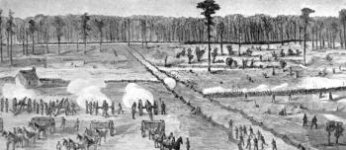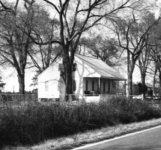Gypsy Heart
Gold Member
On the Cape Fear River during the late eighteenth and early nineteenth centuries, only Fayetteville's and Wilmington’s populations outnumbered Averasboro’s.
Migrating from Scotland, John McAllister, was the first European settler to this former town in present-day Harnett County. He established a gristmill, on a creek that became known as McAllister’s Creek (now known as Bumpas Creek). John Matilinear, a German living on the west side of the Cape Fear, soon operated a ferry, and by 1756 the King’s Highway, later known as the Post or Old Stage Road, connected Hillsboro to Brunswick. By 1766 the Avera family also settled in the region.
In 1791 the North Carolina General Assembly incorporated the town named for William Avera, a prosperous planter and landowner, and originally known as Averasburg. (Eventually the English “boro” replaced the Scottish “burg.”) In 1774 Avera bought McAllister’s’ Grist Mill and opened a tavern at the intersection of Old Stage Road and the ferry’s dock. In 1791 he donated 120 acres to establish the town on the banks of the Cape Fear River, twenty-five miles north of Fayetteville. The first commissioners included William Avera, Robert Draughon, Philemon Hodges, William Rand, and David Smith. On October 1, 1794 a post office began operation. Legend has it that the North Carolina legislature could have named Averasboro, the capital of the state, but the bill failed by one vote. Raleigh therefore became the state capital.
Nevertheless, Averasboro was a thriving town during most of the nineteenth century. With a population of 600, it served as an important terminus by 1860 for inland farmers transporting naval stores (tar, pitch, and turpentine) and corn and cotton on flat river rafts to Fayetteville. Residents had established an academy, a Masonic lodge, and two churches, too. At the start of the Civil War, the town served as a major recruiting station for young Confederates in Harnett County.
On March 16-17 1865, three miles south of the town, war came. More than thirty thousand Federals battled six thousand Confederates on a narrow strip of land between Black River and the Cape Fear River. Led by Lieutenant General William J. Hardee, Confederates successfully checked and delayed the Union forces and allowed time for Confederate General Joseph E. Johnston to organize his forces to fight at Bentonville.
Notorious Ku Klux Klan activity during Reconstruction and the completion of Southern Railway line, which passed through Dunn, four miles east of Averasboro, contributed greatly to the town’s demise. A government informant secretly attended Klan meetings and later reported who actively participated in the Klan. Before the federal marshals arrived in Averasboro, many had fled the state; some relocated in places as far away as Texas. By 1887 the Southern Railway line attracted any remaining Averasboro residents.
Only a cemetery surrounded by a grove and a Civil War museum remind anyone passing through that a port town existed.
Great Map of Civil War battle
http://digital.lib.ecu.edu/historyfiction/viewer.aspx?id=cr4&p=039
Migrating from Scotland, John McAllister, was the first European settler to this former town in present-day Harnett County. He established a gristmill, on a creek that became known as McAllister’s Creek (now known as Bumpas Creek). John Matilinear, a German living on the west side of the Cape Fear, soon operated a ferry, and by 1756 the King’s Highway, later known as the Post or Old Stage Road, connected Hillsboro to Brunswick. By 1766 the Avera family also settled in the region.
In 1791 the North Carolina General Assembly incorporated the town named for William Avera, a prosperous planter and landowner, and originally known as Averasburg. (Eventually the English “boro” replaced the Scottish “burg.”) In 1774 Avera bought McAllister’s’ Grist Mill and opened a tavern at the intersection of Old Stage Road and the ferry’s dock. In 1791 he donated 120 acres to establish the town on the banks of the Cape Fear River, twenty-five miles north of Fayetteville. The first commissioners included William Avera, Robert Draughon, Philemon Hodges, William Rand, and David Smith. On October 1, 1794 a post office began operation. Legend has it that the North Carolina legislature could have named Averasboro, the capital of the state, but the bill failed by one vote. Raleigh therefore became the state capital.
Nevertheless, Averasboro was a thriving town during most of the nineteenth century. With a population of 600, it served as an important terminus by 1860 for inland farmers transporting naval stores (tar, pitch, and turpentine) and corn and cotton on flat river rafts to Fayetteville. Residents had established an academy, a Masonic lodge, and two churches, too. At the start of the Civil War, the town served as a major recruiting station for young Confederates in Harnett County.
On March 16-17 1865, three miles south of the town, war came. More than thirty thousand Federals battled six thousand Confederates on a narrow strip of land between Black River and the Cape Fear River. Led by Lieutenant General William J. Hardee, Confederates successfully checked and delayed the Union forces and allowed time for Confederate General Joseph E. Johnston to organize his forces to fight at Bentonville.
Notorious Ku Klux Klan activity during Reconstruction and the completion of Southern Railway line, which passed through Dunn, four miles east of Averasboro, contributed greatly to the town’s demise. A government informant secretly attended Klan meetings and later reported who actively participated in the Klan. Before the federal marshals arrived in Averasboro, many had fled the state; some relocated in places as far away as Texas. By 1887 the Southern Railway line attracted any remaining Averasboro residents.
Only a cemetery surrounded by a grove and a Civil War museum remind anyone passing through that a port town existed.
Great Map of Civil War battle
http://digital.lib.ecu.edu/historyfiction/viewer.aspx?id=cr4&p=039





